You may know my frustration with this grain and trying to learn to bake with it at 100%. With much advice and good helpful suggestions from many here, you know who you are so thank you, I think my fifth bake is the best so far without having seen the crumb.
So what changed with this bake? First was a drop in hydration from 80% to 75%. This really did seem drier than I am used to dealing with and now that I think I have the fermentation a bit better figured out, I think I would increase this back up. The dough was so NOT sticky that I didn’t really need to wet my hands to do the coil folds. I still did a fair number of slap and folds, but I didn’t do a lamination. The reason for this is that I was worried about the gluten and didn’t want to stress it by doing a lamination. Whether or not that was a good thing to leave out, who knows. I did four coil folds during bulk after an initial bench letterfold and ended bulk at only 40% rise in the aliquot jar. Other than for baguettes where I end bulk at 20%, this is the lowest I ever end bulk. But for this flour going to 50% was too far. Then the dough was shaped and left for 30 mins on the bench until the aliquot jar reached 45% and then placed in the fridge at 3ºC. After a few hours in the fridge I noticed that the dough had risen further which I’m not used to seeing in my cold retarded doughs. So after a short for me 8 hour cold retard I decided to bake. This is what came of all of this.
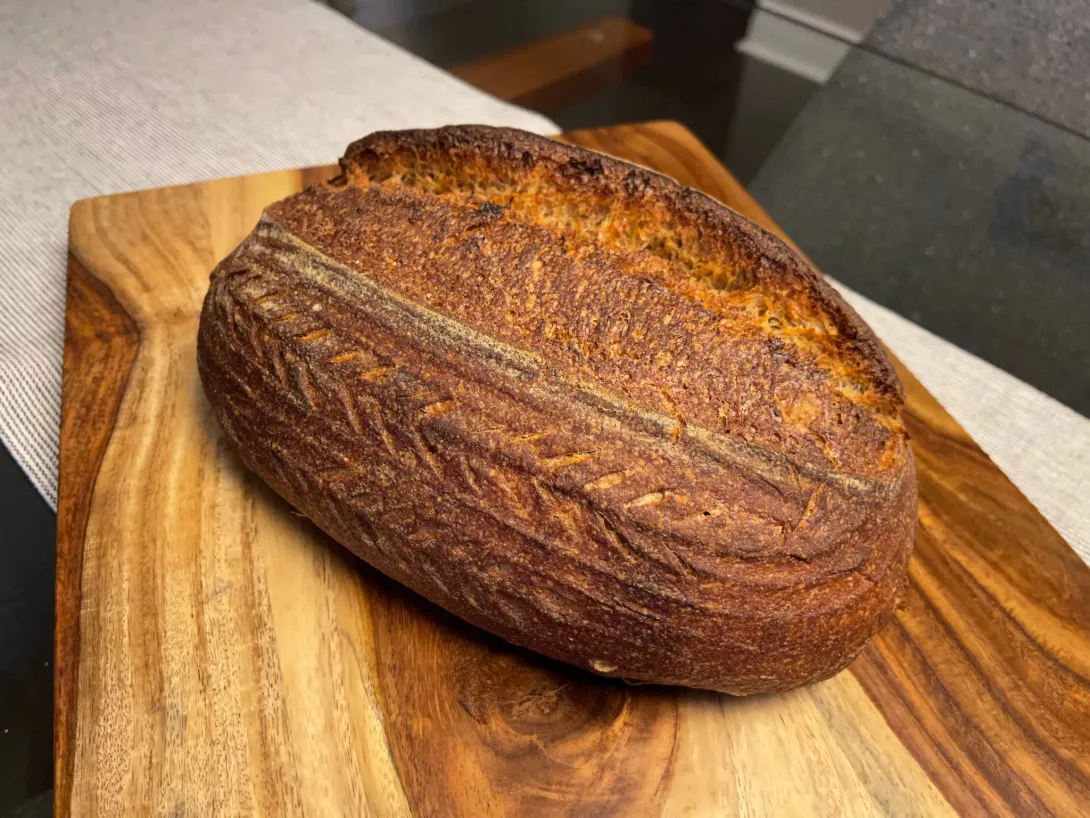
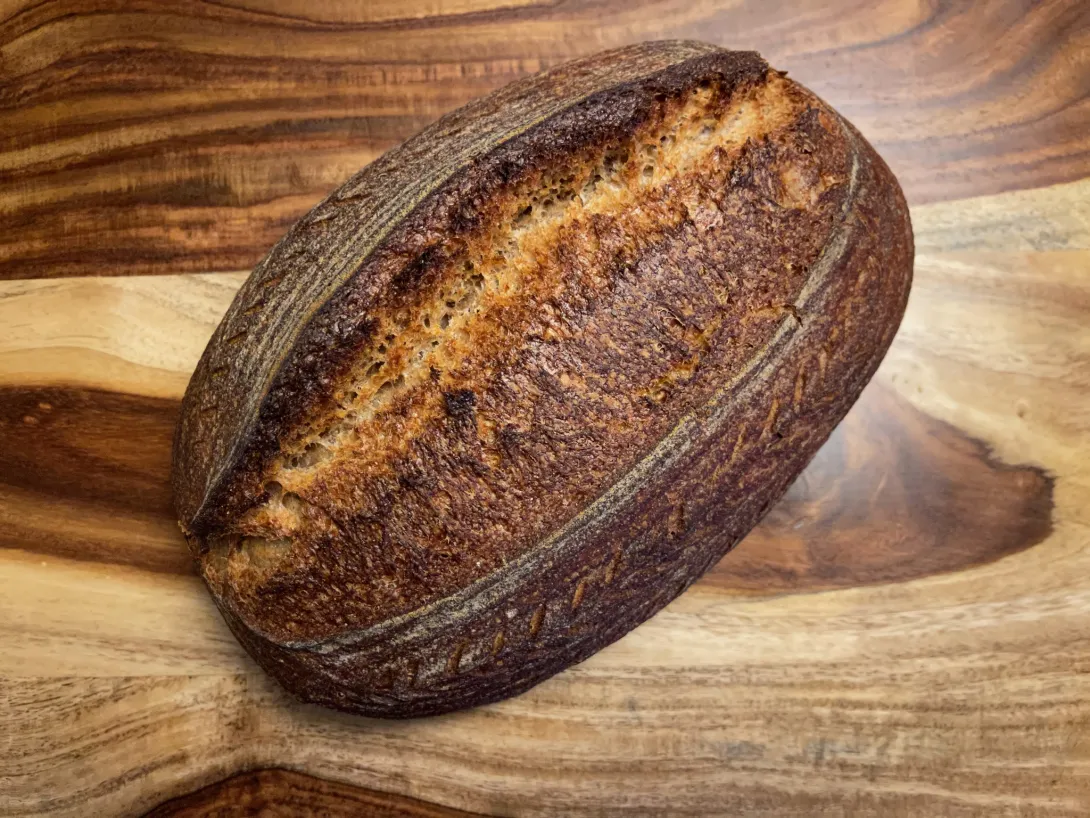
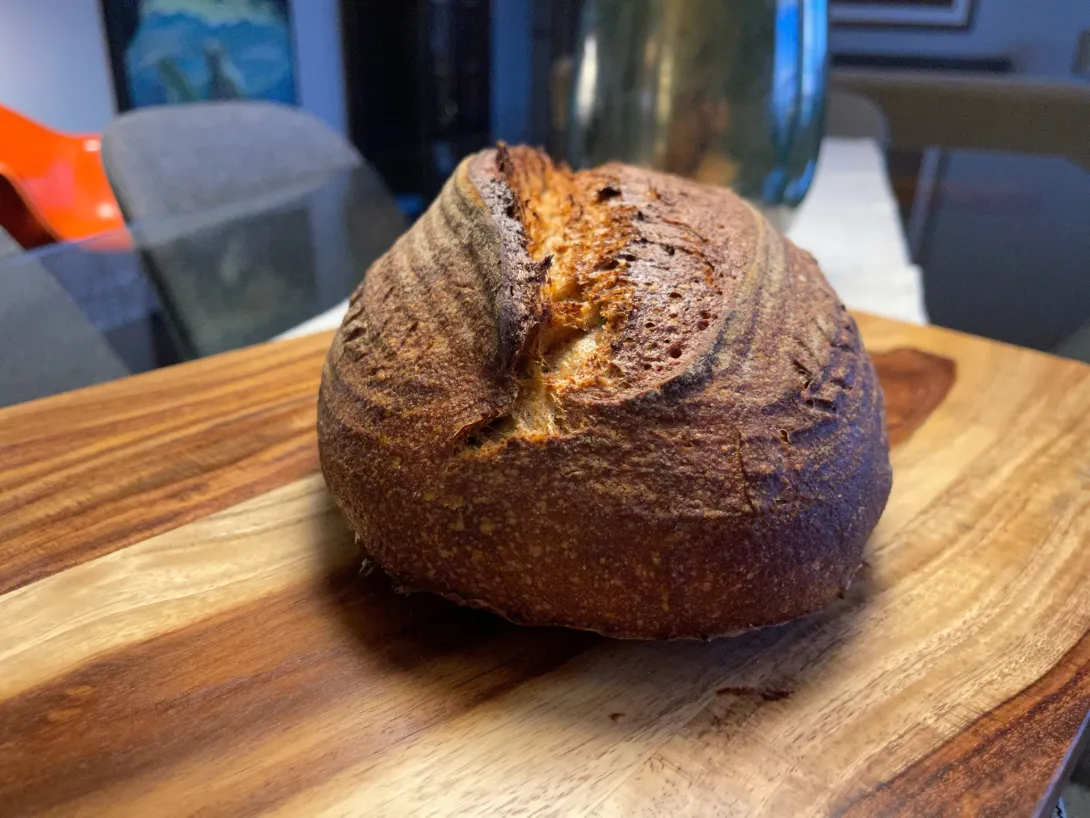
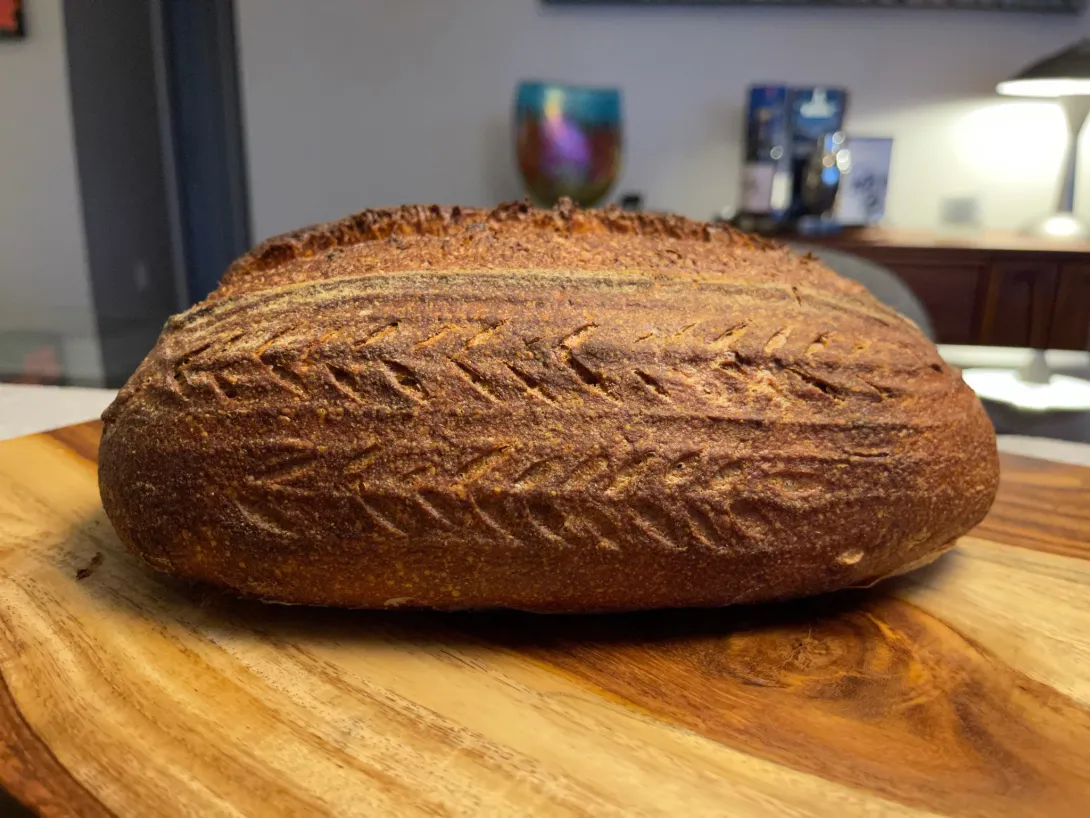
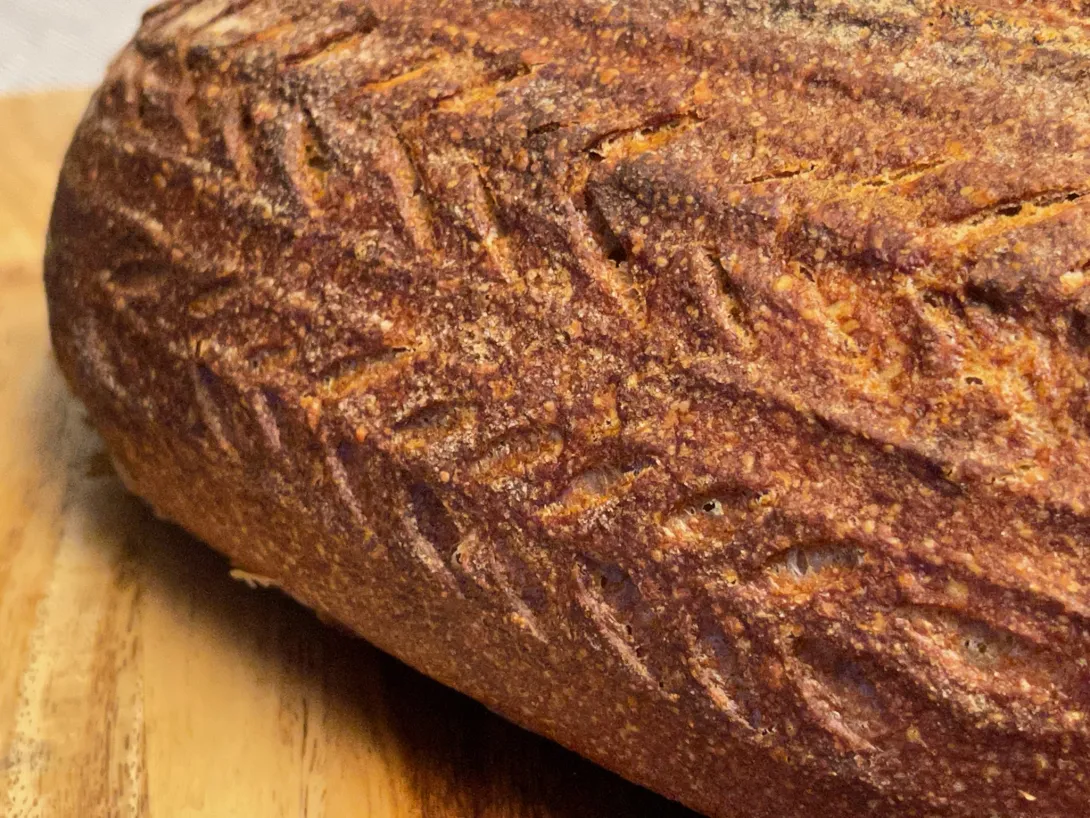
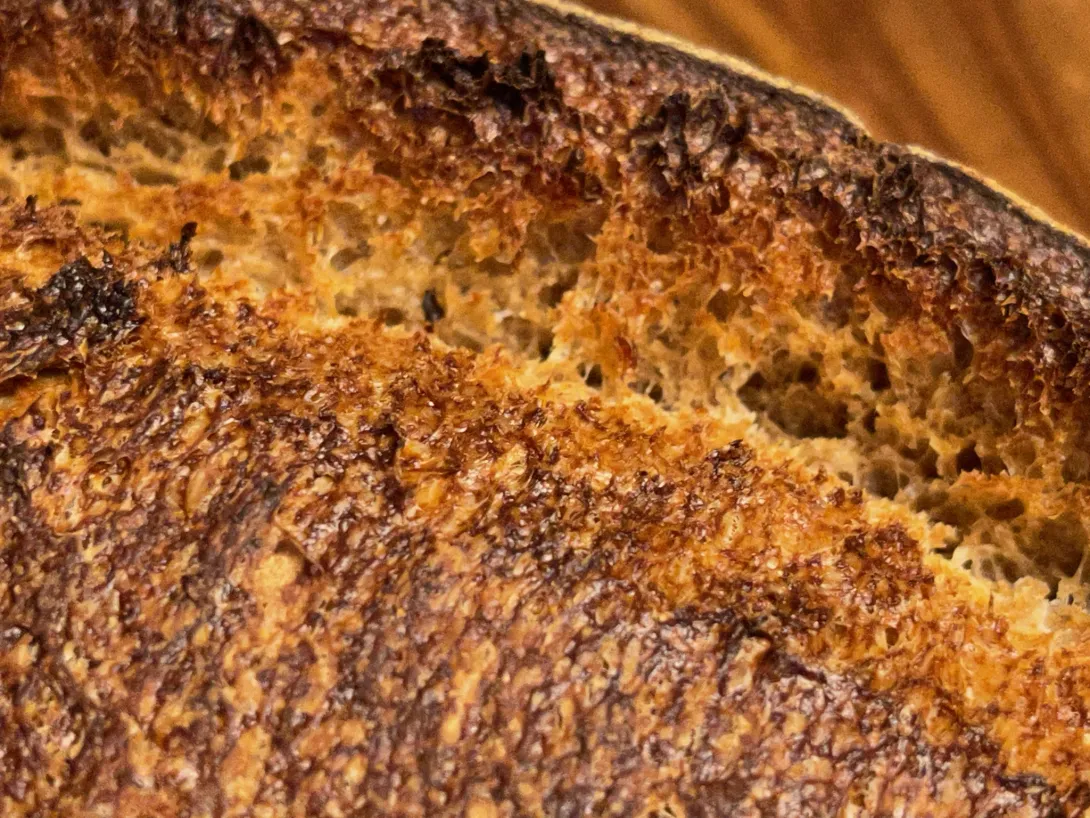
- Benito's Blog
- Log in or register to post comments
I'm excited for you, this looks great! Looking forward to the crumb. ?
Thank you Mary, I’m nervous about the crumb, the loaf overall is so small compared to what I’m used to baking. This won’t be an open crumb bake that’s for sure. I’ll just hope for a decent crumb for a 100% wholegrain sourdough loaf.
Benny
...pation. This week's episode of Benny and the Red Fife has left me on a cliff hanger.
Worried that the crumb will show signs of underfermentation, but on the other hand it did rise in the fridge, and on the other other hand you caught it in time. And we know red fife needs less!
-Jon
P.S. are you using the bottom shelf of your fridge? I actually use the 'crisp' drawer as it is measurably colder.
LOL Jon. I use a low shelf and I have measured the temperature there with a glass of water and it does show 3ºC.
I can’t say that I’m too disappointed in the crumb, sure I’d like it to be more open, but for a 100% wholegrain and this particular wholegrain I’m happy with it. I would try to increase the hydration while maintaining the degree of fermentation with the next bake. This one isn’t overproofed or underproofed to my eye.
This is your best 100% RedFife loaf, Benny. So beautiful, it's perfect. I love that crumb.
Thank you Mariana, that is so kind of you to say. Of course I am a tinkerer LOL, so I’m thinking next time increase the hydration 78% maybe and also maybe bulk to 50% shape and bake immediately, or shape at 40% again and bake at 50%.....
Benny, is it tasty? Taste, fragrance, flavor are the most important qualities in bread, because bread is food and bread is a gift from the baker to the rest of us, the rest is cosmetic and has to do with shaping, scoring and oven management skill.
If you like the taste, then you achieved your goal. If not, yes, I agree, I would also keep adjusting its hydration and length of fermentation at different temperatures.
Yes it is tasty but the texture of the crumb was better at higher hydration. So yes I’m not finished with this one yet.
Beautiful crumb. And interesting observation about the texture. It will be interesting to see what works best for you.
Mary
Thank you Mary, I will continue to play around with this, but I may take a break from it for now after 5 bakes in 4 weeks I’d like to eat other breads LOL.
Benny
That looks like a really nice light crumb, especially for such a finicky heirloom grain.
Given what I had been baking this one is definitely the best one so far. I think/hope I can improve on it a bit with higher hydration but we’ll see, that’ll be a future bake.
Benny
I picked up some Red Fife berries to try a few bakes, and the dough I've made is behaving very strangely. Kudos on getting a nice loaf with this. I ground it at a very fine setting in 1 pass but restricted the intake to reduce heat. I might try a coarser grind in a subsequent bake. I did a very low hydration overnight soaker in the fridge (< 40 F) and used an active but low pH 60% hydration desem starter at 58 F (pH = 4.4) and 20% PFF to get through BF quickly before it degrades (based on reported fermentation intolerance). I also sifted, toasted, scalded, and pre-soaked the bran in the fridge overnight to reduce potentially harmful enzyme activity. I pulsed the pre-dough, bran, and starter in the food processor for 30 seconds with a plastic blade to get a head start on mixing followed by about 150 FF's to complete mixing and another 700-800 Rubaud scoop-and-lifts. I was expecting it to come apart and come together eventually, but the dough seems incredibly fragile, and my sense is that the more I strive for a windowpane the worse it ends up. I often hear it is difficult to overwork dough through manual approaches, but I'm curious if this bran heavy fragile heritage grain is a special case. I've been adding water incrementally with the sprayer but would estimate the current hydration is slightly less than 75%. It is at the point where Rubaud just starts to feel natural. When I attempt a windowpane I get a very shaggy sheet of dough that tares quickly and pulls off very easily. The dough is also more porous than I am used to and doesn't seem to be smoothing out. I'm curious if this dough might benefit from a more hands-off approach. I know you have been having luck with some intense FF sessions (> 1000). How many FF's do you end up using with this flour? Does any of this sound familiar? I took a few videos and may get around to posting them for more ideas. I've just finished the post-mix kneading and am thinking about the next steps.
As you know I don’t have a home mill so have no experience with freshly milled flour, although I “think” that the flour I’ve been using recently is relatively fresh. With this most recent bake at only 75% hydration, the dough didn’t take nearly as many FF to come together and seemed very strong and not sticky. Given the amount of bran it is hard to truly get a great windowpane, but I certainly was able to pull a reasonable one. I also handled the dough much less this time avoiding a lamination which I almost always do again worried about the gluten being fragile. That being said, I don’t recall the dough feeling fragile, in fact, I have felt like this was fairly strong. The only signs of weakness came when baking and the dough would collapse from overproofing in previous bakes.
I think the maximum FF I’ve done with this flour was 800 but with the low hydration on this bake I think I only did about 400. I unfortunately didn’t note that this time.
I’m very happy that you have been able to get some of this grain. You might be better at figuring this out than I have been, although this last bake was the closest I’ve come to hitting my target. I now need to increase the hydration keeping the fermentation down.
Thanks for sharing your observations. I'll try to document this one and will keep my fingers crossed. I feel like I've done something wrong but am not sure what :) I know you aren't milling but wanted to include a comprehensive overview in case any steps have put me on the wrong path. The dough does seem to improve after relaxing a bit but feels different than anything I've encountered so far -- active gluten development seems to make it porous instead of smoother. I would be more than happy to make something close to what you posted here. It is a nice-looking loaf of bread. I've picked up a few local NY flours, which aren't as hardy as the varieties from the drier great plains regions, and I am now curious about how to best approach weaker and fermentation intolerant flours in general.
I’m looking forward to your bake, fingers crossed here as well.
Oh I forgot to mention a thought I’ve recently had about this flour that might explain its intolerance to fermentation. I have no information to support this just conjecture on my part from working with it, but I wonder if this flour has unusually high concentrations of protease enzymes in it. If it did, it would explain why as fermentation progressed and pH falls and activates the enzymes that the gluten seems to fail after having been so strong earlier during bulk. Or perhaps it protease enzymes may be a variant that activates at a higher pH than the proteases of most other flours.
I bought Turkey Red and Red Fife from Janie's mill. These are freshly milled flours, and I had much better luck with the Red Fife than the Turkey Red. Though the Turkey Red has a beautiful dark color, I can't seem to make anything out of it that works. The Red Fife had a high absorption rate listed, which I think is another point in its favor. But if freshly-milled flours in general are so much higher in enzymes, it might be better to avoid..?
Hi Sue, you’ll have to try and experiment with your new flours. I do think that the red fife might be high in proteolytic enzymes that is the only thing I can think of that would cause it to be fermentation intolerant. Your even more freshly milled flour may be even more active than mine. I would give it a go and try to bake with it, just don’t go crazy like I initially did with high hydration and pushing bulk and final proofing so far. I’ll be very interested to see what you bake.
Benny
With the Turkey Red, because I have 20 lbs of it! If nothing else, it will be good for pan bread.
I think I will buy more of the Red Fife, as I just had a 3 lb bag. As my main ww flour, I am using Bronze Chief, which is really lovely to work wiith.
thanks again!